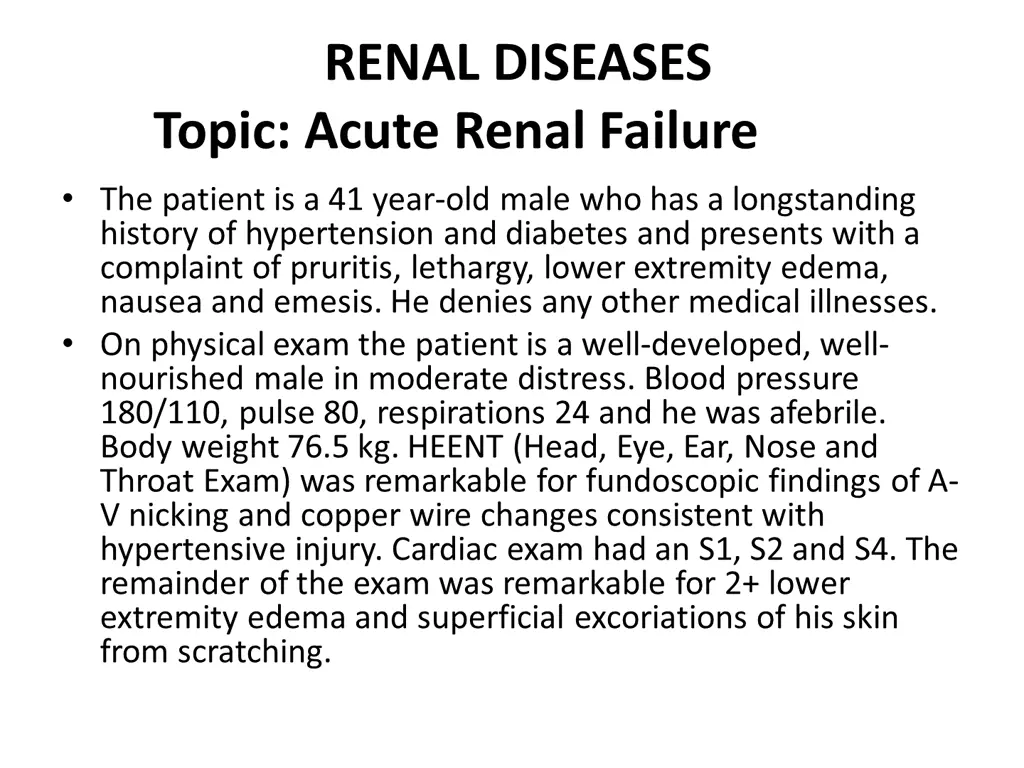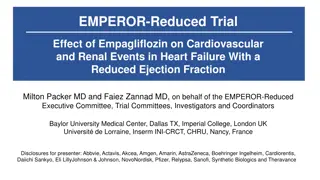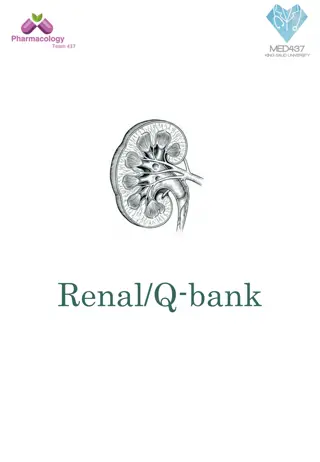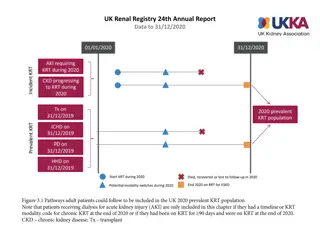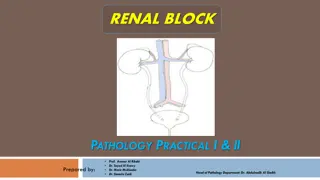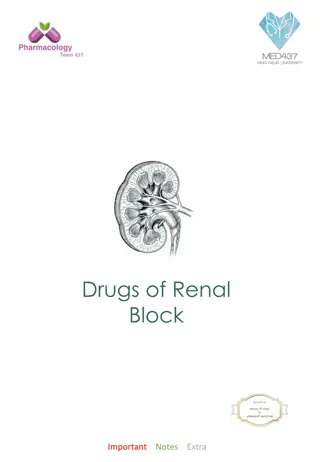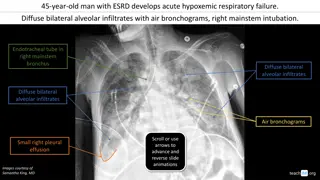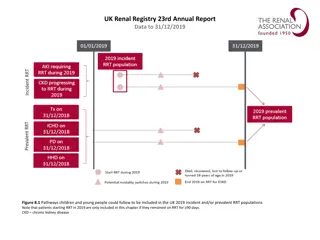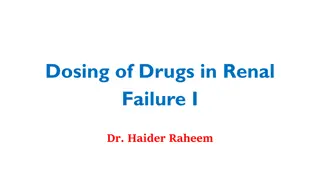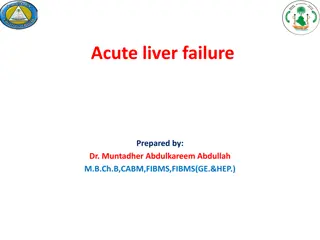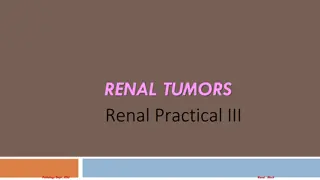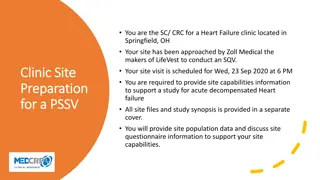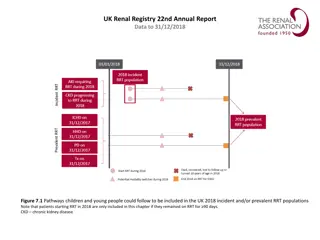RENAL DISEASES - Topic: Acute Renal Failure
Discusses a case of acute renal failure in a 41-year-old male with a history of hypertension and diabetes. It covers the patient's symptoms, laboratory data, and possible causes.
Download Presentation

Please find below an Image/Link to download the presentation.
The content on the website is provided AS IS for your information and personal use only. It may not be sold, licensed, or shared on other websites without obtaining consent from the author. Download presentation by click this link. If you encounter any issues during the download, it is possible that the publisher has removed the file from their server.
E N D
Presentation Transcript
RENAL DISEASES Topic: Acute Renal Failure The patient is a 41 year-old male who has a longstanding history of hypertension and diabetes and presents with a complaint of pruritis, lethargy, lower extremity edema, nausea and emesis. He denies any other medical illnesses. On physical exam the patient is a well-developed, well- nourished male in moderate distress. Blood pressure 180/110, pulse 80, respirations 24 and he was afebrile. Body weight 76.5 kg. HEENT (Head, Eye, Ear, Nose and Throat Exam) was remarkable for fundoscopic findings of A- V nicking and copper wire changes consistent with hypertensive injury. Cardiac exam had an S1, S2 and S4. The remainder of the exam was remarkable for 2+ lower extremity edema and superficial excoriations of his skin from scratching.
Chemistry Observed Values Normal Values Urinalysis Sodium 133 136-146 mmol/L Potassium 6.2 3.5-5.3 mmol/L Laboratory Data Chloride 100 98-108 mmol/L Total CO2 15 23-27 mmol/L BUN 170 7-22 mg/dl Creatinine 16.0 0.7-1.5 mg/dl pH 6.0 Specific gravity 1.010 Protein 1+ Glucose negative Acetone negative Occult blood negative Bile negative Waxy casts Glucose 108 70-110 mg/dl Calcium 7.2 8.9-10.3 mg/dl Phosphorus 10.5 2.6-6.4 mg/dl Alkaline Phosphatase 306 30-110 IU/L Parathyroid Hormone 895 10-65 pg/ml Hemoglobin 8.6 14-17 gm/dl Hematocrit 27.4 40-54 % Mean cell volume 88 85-95 FL
24-hour urine protein and creatinine - volume 850 ml, protein 600 mg/dl and creatinine 180 mg/dl. Renal ultrasound- Right kidney 9 x 6.0 cm, Left kidney 9.2 x 5.8 cm Both kidneys illustrate hyper-echogenicity and no hydronephrosis.
1. "presents with a complaint of pruritis, lethargy, lower extremity edema, nausea and emesis." what does the symptoms suggest to you? Uremia Symptoms of uremia are are non-specific. You have to keep this possibility in mind whenever there is consideration for renal disease. Lethargy Nausea and vomiting Fatigue Lethargy Pruritus
2. What are the fundus changes in a hypertensive? AV nicking Hemorrhage Papilloedema 3. What are the fundus changes of a diabetic? Exudates Hemorrhage Neo-vascularization Aneurysms
4. What does S4 signify? What cardiac findings will you expect to find in a hypertensive? Apical impulse low and out Sustained apical impulse Loud A2 component over aortic area S4 5. What are the possibilities for his symmetrical 2+ lower extremity edema? Congestive heart failure Hypoalbuminemia Water retention from renal failure
6. What is the significance of the finding superficial excoriations of his skin from scratching. ? Uremia leads to pruritus and explains the excoriations from scratching. 7. Why was a renal ultrasound ordered? What information can you gather from renal ultrasound studies? To determine kidney size echogenicity rule out obstruction
8. What evidence in renal ultrasound will suggest obstruction? Obstruction Large kidney Dilated calyses Dilated ureter 9. Is the cause of this patients renal failure acute or chronic? How did you arrive at that conclusion? Chronic Acute: Short duration and rapid rise of BUN and creatinine. Chronic: Long duration of BUN and creatinine elevation, Hemoglobin is low, Calcium and Parathormone disturbances
10. What is the calculated GFR? 140-41 (76.5 kg) = 6.6 ml/min 72 x 16.0 11. What would be the calculated GFR in this case if the patient was female? (140-41) (76.5)=6.6 x .85=5.6 72 x 16 females have less muscle mass per kilogram than males. 12. What is the 24 hour urine protein excretion in this patient? 600 mg/dl x 8.5 dl) = 5,100 mg
13. Is this 24 hour urine collection adequate? How did you arrive at that conclusion? Yes; (180 mg/dl x 8.5 dl) = 1530 mg creatinine; 1530 mg/76.5 kg = 20 mg/kg. This is adequate for a male patient. 14. How is a 24 hour urine to be collected and when is it appropriate to order this test? Method of collection The first morning void should be discarded. All following voids should be saved in the container provided including the following morning sample. When appropriate It is only appropriate to get a 24 hour urine sample for protein and creatinine clearance when renal function is in a steady state. If the function is acutely deteriorating at the time of collection the GFR will be overestimated and if the function is improving during the collection, the measured GFR will be underestimated.
15. What is the measured GFR in this patient? (180 mg/dl x 850 ml/1440 min) = 6.6 ml/min (16.0 mg/dl) 16. Why is the parathyroid hormone elevated? Due to the decrease in GFR there is decreased excretion of phosphate. This results in a decrease in serum ionized calcium and stimulation of parathyroid hormone release. 17. What is the most likely cause of this patients anemia? Decreased erythropoietin. This is typically a normochromic and normocytic type of anemia.
18. Should this patient be started on dialysis? What are the indications for dialysis? Yes, indications to be considered for dialytic therapy include abnormalities in acid-base balance electrolyte disturbances volume overload dialyzable toxins uremia. This patient demonstrates symptoms of uremia. 19. What is the most likely diagnosis for his renal disease? How did you arrive at that conclusion? The leading cause of end stage renal disease is diabetes. The most likely cause in this case is diabetes because of the bland urinary sediment nephrotic range proteinuria long history of diabetes.
20. Could his renal failure be due to hypertension? What evidence you will need to implicate hypertension as the cause for his renal failure? A longstanding history of uncontrolled hypertension and diabetes reported could be an implication for RF. 21. If you were to place this patient on a 2 gram sodium diet how many milliequivalents of sodium would this diet contain? 2,000/23 m.w.(molecular wt.)=87 meq. 22. How many grams of sodium chloride would this be? (87 meq) x (58 m.w.) = 5 grams.
